
Technology is powering the rise of smart cities, transforming everything from traffic management to waste collection. We dig into the digital revolution giving rise to cities that are more connected, sustainable, and efficient — and what the future of urbanization might look like.
Where is this data coming from?
Cities are evolving at a rapid pace.
Over half the world’s population currently lives in urban areas. By 2050, that number is expected to jump to 68%, per the UN.
Along with a growing population, new challenges are emerging as cities look to improve everything from infrastructure to connectivity. Many see this as a viable business opportunity, developing technology to help cities efficiently provide proper foundation, energy, transportation, resources, jobs, and services to their residents.
As a result, cities are undergoing a digital transformation — turning into “smart” cities.
The global smart cities market size is projected to be worth $1.3T, according to CB Insights’ Industry Analyst Consensus.
Several players, from tech giants to telecom companies to governments, are working on initiatives to make cities smarter and more efficient.
Additionally, in the wake of Covid-19, a number of regions have leveraged smart city tech to contract-trace and control outbreaks. In Singapore, for instance, citizens can download an app that relies on Bluetooth signals for contract tracing, while Taiwan set up a digital fence system that tracks cellular signals in order to enforce home quarantine.
In this analysis, we look at what smart cities are, the various components of the city that are becoming increasingly connected, players across the ecosystem, emerging challenges, and what the future holds.
Table of contents
- What is a smart city?
- Smart city breakdown
- Public health
- Transportation
- Sustainability
- Public services
- Who’s investing in the future of smart cities?
- Challenges and criticisms
- Conclusion
What is a smart city?
A city is considered to be “smart” when it can collect and analyze mass quantities of data from a wide variety of industries, from urban planning to garbage collection. In a smart city, a complex network of interconnected sensors, devices, and software must be built and maintained.
This should allow the city to become a more sustainable and efficient environment for its residents.
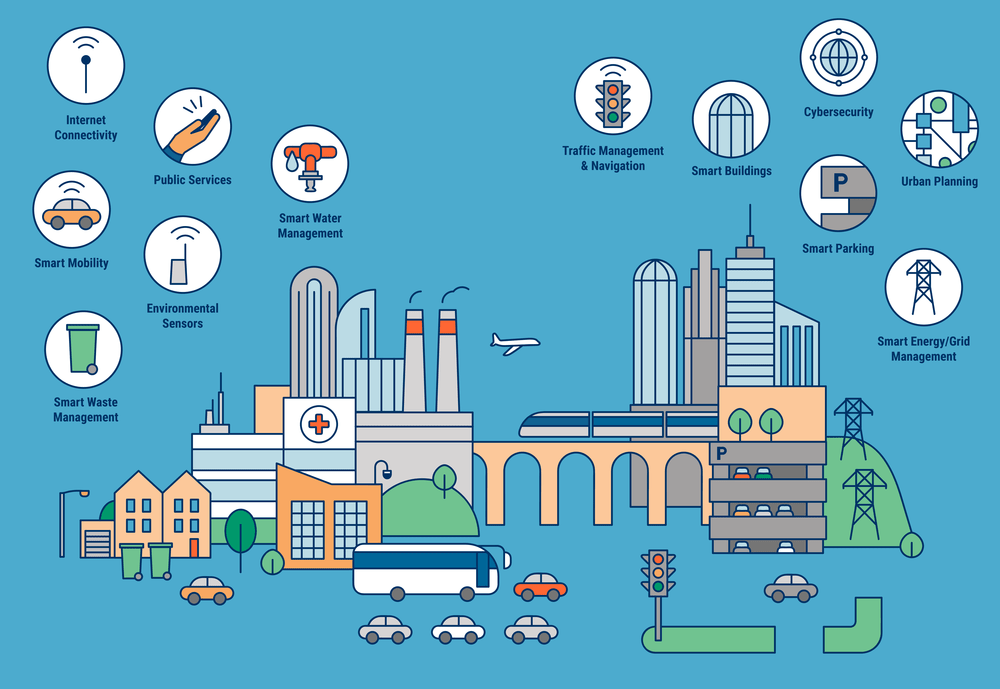
Smart cities are supported by several types of technologies, including:
- Information and communications technology (ICT)
- Connected physical devices using the Internet of Things (IoT) network
- Geographical information systems (GIS)
Each works together to collect and contextualize massive amounts of data that can be used to improve the components and systems running within a city.
The ICT framework, for example, is made up of various machines and sensors that are all connected to the IoT network, and can instantly transmit data using wireless technology and the cloud. Traffic in a given area, for instance, can be monitored using sensors.
Cloud-based IoT applications can then receive, analyze, and manage that traffic data in real time. This data can also be used to better understand and respond to a city’s constantly changing needs over time, and can even be used to better optimize for safety.
Smart cities can also leverage GIS for planning and mapping purposes, as well as for improved development of cities. As a result, urban areas are able to better manage issues from water management to excessive energy consumption to insufficient waste management.

Using GIS for smart water management. Source: Ceinsys Tech
Smart cities may also utilize artificial intelligence (AI) and blockchain technology for certain systems. Some companies, for example, are working to make parking easier and more efficient using AI-directed facilities. Other companies allow city dwellers to buy and sell energy to their neighbors via blockchain technology.
These are just a handful of technologies working to support the emergence of smart cities. And over time, a successful smart city should in theory be able to respond to incoming data much like a single intelligent organism, seamlessly and efficiently providing itself with exactly what the city and its citizens need, without wasting any resources and without any human error.
Smart city startups
These 1,200+ companies are developing solutions and services for cities of the future, revolutionizing sectors like public safety, transportation, and utilities management.
Smart city breakdown
Several areas across the city are becoming “smarter,” from traffic control to water management, with various companies working across the different components.
Public health
The Covid-19 pandemic has highlighted the potential of smart cities in bolstering pandemic preparedness. Integrating smart city tech like thermal cameras and IoT sensors with AI can help prevent the spread of infectious diseases.
For example, the UAE provided its police with smart helmets equipped with thermal cameras, face recognition sensors, and license plate readers to track and monitor citizens.
Improving data governance and government services has also been crucial in combating Covid-19.
Korea and Singapore both assembled public maps of confirmed Covid-19 cases, allowing citizens to see patients’ location histories and allowing them to stay clear of outbreak zones.
Taiwan integrated its national healthcare system with its immigration database, allowing medical officials to send real-time alerts to doctors about which patients were at higher risk for contracting Covid-19 based on their travel history. Local developers have also set up public dashboards that visualize the real-time supply of masks and other supplies at local pharmacies.
Smartphones, as an essential component of smart cities, also play a critical role in handling outbreaks. Their increasingly advanced biosensors, elevated processing power, and high-speed connectivity make them ideal candidates for boosting pathogen detection, for one.
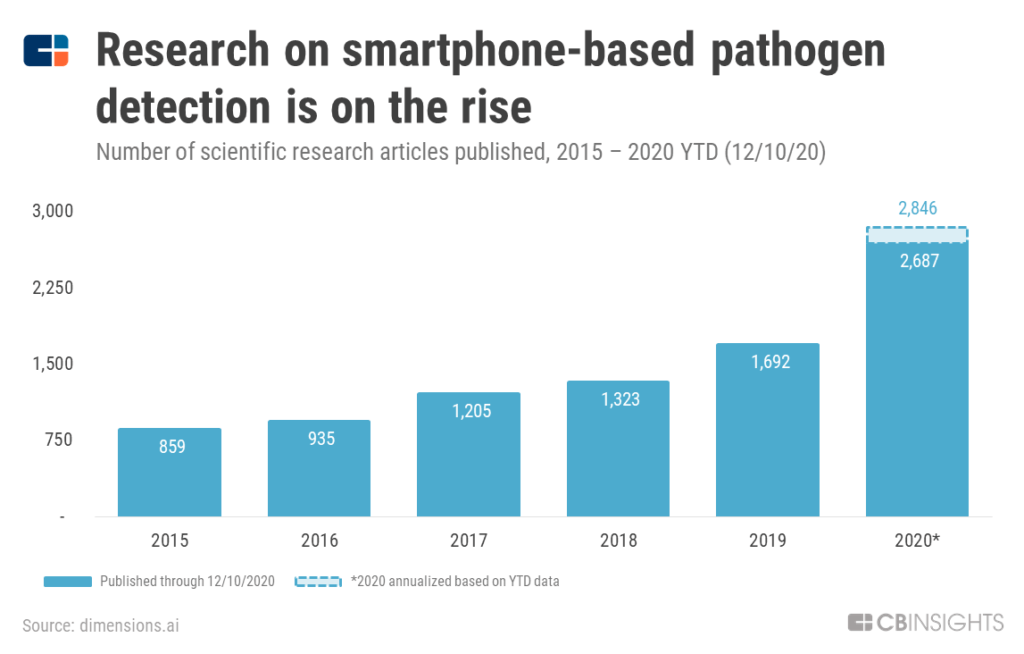
Several countries have also leveraged a smartphone-based tracking system to enforce home quarantines.
Early on in the pandemic, Taiwan leveraged mobile phone tracking by employing a digital fence system that uses location data from cellular signals already collected by telecommunications networks.
Korea has used data from GPS phone tracking as well as credit card records and surveillance video to trace the movements of its citizens and inform the public if they’ve been in contact with anyone who was infected.
Singapore has implemented contact tracing via 2 systems: the SafeEntry program consists of QR codes that citizens scan to enter public arenas like malls or offices, which alerts them if an active carrier is in the same location; while the TraceTogether program uses Bluetooth-enabled smartphones or tokens to track close encounters with infected people.
The implementation of these protocols has raised concerns regarding privacy and surveillance, but many officials have emphasized the emergency nature of the situation. Other regions have opted for voluntary, rather than mandatory, contact tracing.
The pandemic has undoubtedly accelerated the use of smart city tech in many places around the world. It is likely we will continue to see the proliferation of these tools as cities strive to become more efficient and connected amid public health crises.
Transportation
Traffic management
Smart technology can be used to connect vehicles, infrastructure, public transit, and people to improve mobility and safety.
Streets can be outfitted with sensors that track data both on the roads and through citizens’ cars and smartphones in order to gain insights on traffic flow patterns, road blockages, roadwork, road conditions, and more.
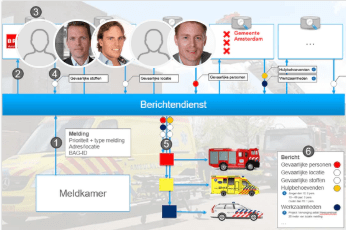
Amsterdam, for instance, already uses a smart traffic management system, where traffic is monitored in real time. This allows the city to broadcast information about current travel times on roads, helping motorists decide on the best route to take at a given time.
Innovation platform Amsterdam Smart City was created to develop solutions for a wide range of metropolitan issues. Projects include everything from building a smart playground to enhancing smart grids to creating a city-wide messaging system.
Barcelona has also integrated components of smart transportation technology into its city. The data gathered from traffic patterns has allowed the city to design a new, more efficient bus network.
The city utilizes intelligent vehicle technology to help manage traffic at its El Prat airport. Smart vehicle company Sensefields has helped El Prat implement traffic control in short-stay “parking express” areas located in departure terminals, as well as in taxi pick-up areas. “Control stations” have been introduced to collect data on the number of vehicles present at a location across different times.
Parking
Aimlessly driving to find a parking spot wastes energy and increases traffic congestion. With the use of smart technology, however, this may become a problem of the past.
Sensors embedded in the ground can be used to identify which parking spaces are available or occupied. These IoT sensors can then transmit this data to a cloud-based smart parking platform, which is aggregated into a real-time parking map of the city. Drivers can pull up this map through an app on their phone, which showcases the nearest parking spots available to them, thus saving time and money.
Additionally, this technology can be used to easily alert parking enforcement officers when a car has parked illegally.
Tracking and managing parking spots might even allow lot owners to implement dynamic pricing. For example, Sidewalk Labs’ portfolio company Coord (which grew out of its transportation coordination platform Flow) looks to improve mobility and efficiencies across cities by opening up its Tolls API to third-party developers.
The company is working on products that can aggregate pricing and toll data to give consumers transparency on how much an entire trip might cost. In the future, it might be able to use this information to help lot owners price their spaces in real time.
The company is working on products that can aggregate pricing and toll data to give consumers transparency on how much an entire trip might cost. In the future, it might be able to use this information to help lot owners price their spaces in real time.

Source: Mozio
Planning for a future with fewer cars
Another aspect of smart cities is shared ride technology.
With companies like Uber and Lyft entering cities across the world, there might not be as much of a need for parking as there is today. In Sidewalk Labs‘ initial vision for the now-shuttered Quayside, the Eastern waterfront it planned to develop in Toronto, the company outlined a stacked parking lot that might transition into other things once autonomous or shared vehicles reduce the need for parking garages. This included green spaces and shopping centers.
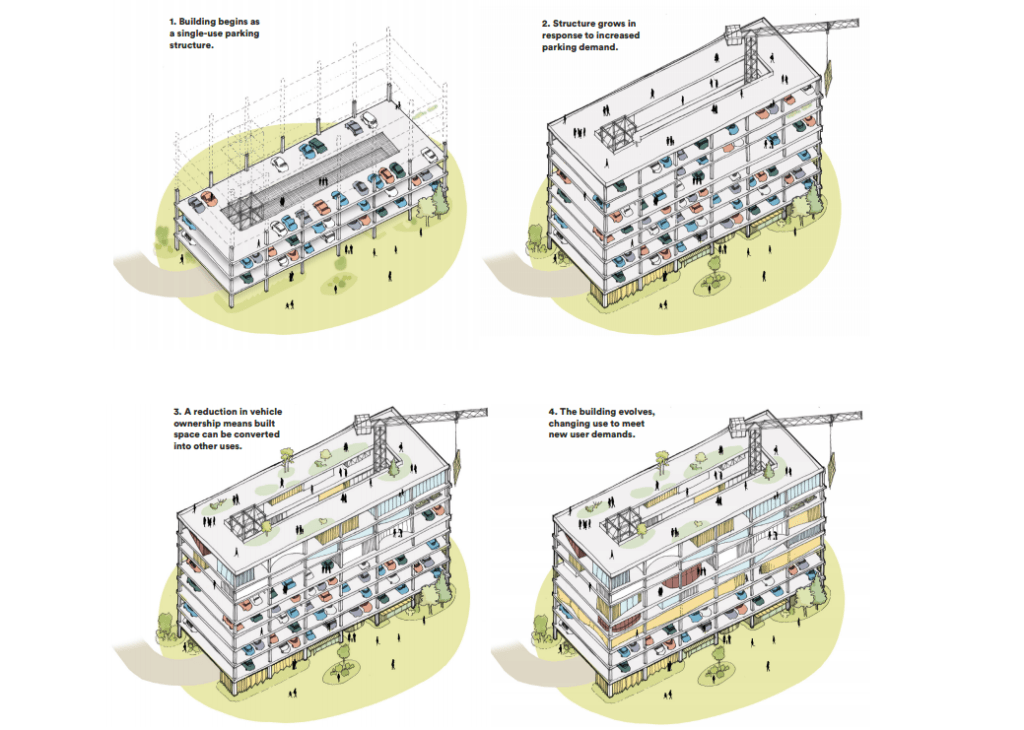
Quayside parking lots could transition over time.
Micromobility
As congestion in cities rises, existing transportation — from cars to buses to trains — can no longer keep up with the growing population. Americans have lost an average of 99 hours a year due to traffic congestion, according to the 2019 INRIX National Traffic Scorecard, and in 2019, traffic cost Americans roughly $88B, or an average of almost $1,400 per driver.
Startups are developing sharing platforms for electric bikes and scooters, which relieve congestion by serving as an alternative to cars for shorter trips and by helping connect people to public transit hubs for longer trips.
Companies such as Bird Rides and Lime offer on-demand scooter rides, while companies like France-based Ecovelo and India-based Yulu Bikes offer rides on electric bikes.
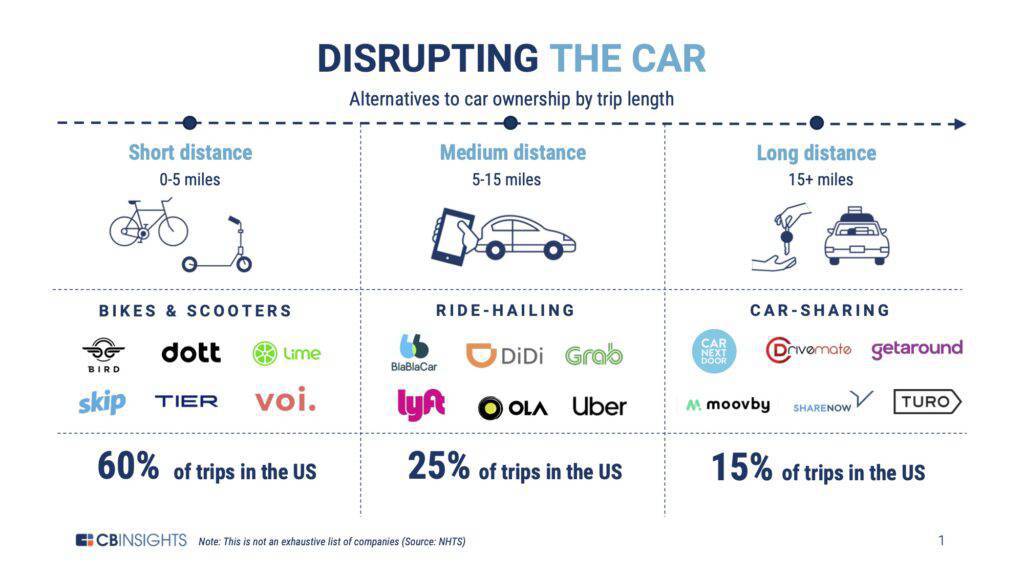
With cities pressed to solve the transportation crisis amid rising concerns around gas-powered emissions, micromobility solutions are emerging as a powerful alternative to the current public transit mix, especially as Covid-19 impacts the sector.
There remains potential for micromobility startups to gain traction as people look for single-rider, open-air transit alternatives. Bikes and scooters could offer safer methods of transportation — allowing for outdoor transit, control over social distancing, and fewer points of shared contact — compared to public transportation.
Fleet management
Transportation companies and other fleet operators leverage fleet management and telematics tech to monitor their vehicles in real time, which can help optimize routes, reduce fuel costs, and lower emissions.
Data collected from fleet management companies could be leveraged to better plan and predict traffic, including leading to the development of truck-only lanes.
San Jose is one example of how a smart city could leverage fleet management software. Boasting 2,750 public vehicles that cover 250 city facilities, the city leverages fleet management software to help the city improve response times to resident calls and consistently track vehicle maintenance needs.
Per fleet manager Dan Sunseri, “We have that additional data that we can bring into our datasets already, take that information, report on it, and get useful information to make key decisions about vehicle purchases, driver behavior, […] idle reduction, and fuel use, so the information is invaluable.”
Another company working on such software is Israel-based Fleetonomy, which was acquired by Via in September 2020. Fleetonomy’s AI-based mobility platforms help fleet operators predict demand, increase fleet utilization, and create new revenue streams.

Source: Fleetonomy
Vehicle-to-everything tech
Vehicle-to-everything tech refers to hardware (e.g. sensors, radar) that lets vehicles communicate wirelessly with other vehicles (V2V), pedestrian devices (V2P), or infrastructure (V2I). This tech’s success largely depends on network effects. For example, once enough vehicles are connected on the road and across infrastructure, it becomes easier to navigate dangerous weather, accidents, and congestion.
California-based Savari is developing sensors and accompanying software to help vehicles communicate with other vehicles and points of infrastructure. The company has received investments from China-based automaker SAIC as well as Infiniti’s accelerator.
Sustainability
A wide range of IoT solutions can be implemented in cities to improve energy efficiency.
Smart street lighting can reduce energy consumption by staying dim when no cars or people are around, then lighting up as sensors detect someone is coming. Chicago has created a program that will replace 270,000 lights with LED lighting equipped with intelligent controls by 2021, saving the city an estimated $10M a year in energy costs. Worldwide, an expected 73M connected street lights are to be deployed by 2026, according to Navigant Research.

Chicago’s city-wide lighting initiative.
Other ways to promote energy efficiency include tapping into forms of energy (e.g. heat, waste) that might otherwise be neglected. In Seoul, for example, local resource recovery facilities transform urban waste into steam to use as an alternate source of energy.
Smart cities can also promote renewable energy by allowing rooftop solar owners to sell to each other or by operating microgrids that can produce energy on site.
Environment monitoring
Through the use of wireless sensor networks, a smart city can gather and analyze data related to environmental factors such as temperature, humidity, and air quality, all throughout specific areas of a city. This is especially critical for reducing levels of air pollution within densely populated areas.
The World Health Organization has reported that an estimated 92% of the global population lives with pollution above recommended limits. About 3M deaths each year are linked to outdoor air pollution.

Varying particle pollution (PM) levels. Source: WHO
To combat this, smart cities are implementing technologies, such as the Bosch Climo climate monitoring system, to collect highly localized air quality information.
Each device throughout a city collects air quality measurements that are then sent to a cloud-based application, where it is broken down into analytics for the government and the public to see. This helps policymakers identify which areas need the most environmental improvements, and helps the public avoid areas that may be especially harmful on a certain day.
Some companies are aiming to reduce the environmental impact of cities by monitoring pollution and modeling severe weather patterns. France-based eLichens, for one, develops sensors to measure air pollution, while Jupiter Intelligence collects and analyzes satellite data to predict severe weather and climate change.
Energy management
Normally, the various systems within a building — such as lighting, video surveillance, climate control, ventilation, and fire protection — do their jobs separately. Smart buildings, however, have all these systems connected through an IoT network, allowing them to communicate with each other and work together to make the building as efficient as possible through continuous adjustments.
Sensors can detect when a particular room or office is vacant and dedicate less lighting and fewer temperature resources to that space. This cuts down the total energy consumption of the building as a whole.
For example, Comfy — which was acquired by Siemens in June 2018 — has created limited, occupant-facing controls that can be used with existing HVAC systems. The company installs sensors and IoT devices in buildings so that occupants can adjust temperature and lighting.

Companies are also attempting to optimize the electrical grid and improve energy efficiency in commercial and residential buildings. For example, ENGIE-backed Energyworx is developing an energy data management platform that ingests and analyzes smart meter and IoT data to generate insights around consumption patterns, which allows utility companies to optimize bidding and pricing decisions.
These initiatives are essential to reducing the carbon footprint of a city, since buildings account for up to 70% of total energy consumption within a city and 30% of greenhouse gas emissions globally.
Waste management
Smart waste management solutions can be implemented to improve waste removal services, reduce operational costs, and improve sustainability.
This can be accomplished through smart waste receptacles that have sensors attached to them that measure fill level. When a bin is full, it can instantly send this information to a cloud-based application that can then optimize the route of waste collection trucks, which can then prioritize pickups at locations with full bins and skip over areas with empty ones.
This is just what the city of Santander, Spain has done. Santander partnered with Japan-based firm NEC to deploy ~6,000 IoT-connected devices around the city to learn the locations and fill levels of garbage bins and containers. The municipality then uses GPS tracking to optimize its waste collection route.
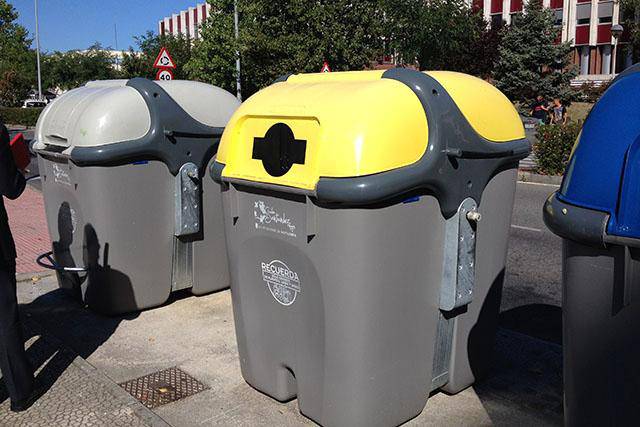
Example of a smart bin.
Smart bins can also help encourage and monitor rates of recycling. Times Square in New York City has set up nearly 200 smart waste and recycling stations with built-in compaction, fullness sensors, and collection notifications. This has resulted in a 40% proper recycling rate and a 50% reduction in collections per week.
Startups are also looking to drive efficiencies and minimize costs in the collection, transport, and treatment of urban waste. For example, AMP Robotics, backed by Sequoia Capital, is developing computer vision and machine learning for recycling centers. Its technology can identify and sort materials faster than humans would.
Water management
Smart water technologies can help improve the sourcing, treatment, and delivery of this essential resource. Through tracking consumption patterns for both utilities and end users, cities can optimize and reduce water waste as well as delivery costs.
Sensors could automatically alert a city to water leaks so it could fix them as quickly as possible. Smart water systems can also measure rainfall and provide real-time flood analysis for flood control.
The city of Castellon, Spain, for instance, has piloted a smart water platform to reduce utility costs and optimize resources via smart water meters equipped with long-range sensors.
A number of companies are improving the way cities clean, distribute, and recycle water. Solutions include cloud-enabled management platforms (e.g. APANA) and data-driven water quality monitoring (e.g. Aquagenuity).
Public services
Governmental services provided to the public tend to be slow and inefficient in many cities. However, with the use of digital technology, public services can be streamlined in a number of innovative ways.
Buenos Aires used to rely on an inefficient telephone hotline system where citizens had to log a complaint or request for public services. It took an average of 600 days — almost 2 years — to resolve issues.
The city has since switched to a mobile app where citizens can snap a photo of the issue, from a large pothole in the road that needs filling to vandalized public property that needs repairing. The app, using an integrated geographic information system (GIS), instantly sends the location and information of the complaint to the ministry, and work is assigned to the closest vendor that can resolve the problem.
Once the issue has been solved, a city street inspector validates the completed work and uploads a picture of the resolved issue to the mobile app, so citizens can see the problem has been fixed. Citizens can even give the public services a rating based on how satisfied they are with the quality of work, so the government can see where it can improve. The average time required to solve a complaint in Buenos Aires has since fallen by 93% with no increase in budget.
Singapore’s Municipal Services Office has also developed a centralized mobile app called OneService, where the public can access services across 11 government agencies and 16 town councils, all from the comfort of their phones.
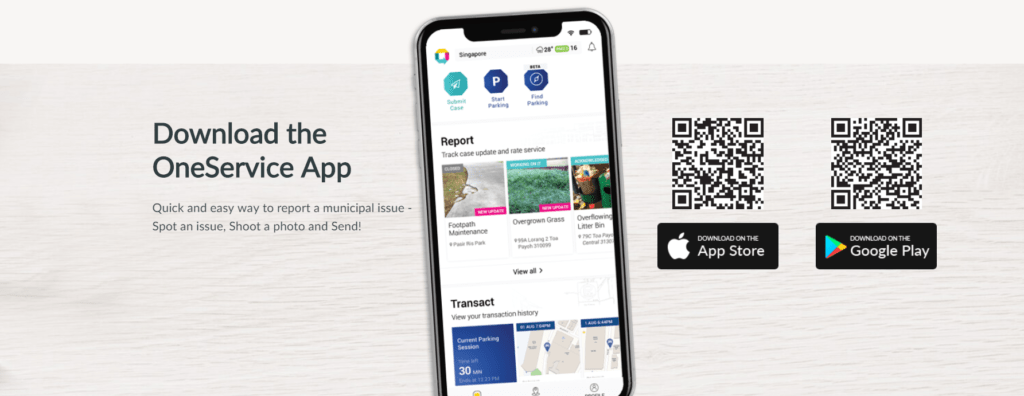
In 2007, Seoul launched the 120 Dasan Call Center. Instead of calling different numbers to reach various district or governmental offices, citizens could just dial 120 to speak with an operator, whether they needed information about tourist sites, public transportation, interpretation, hospitality reservations, or more. The central database also holds 13,000 civil cases, allowing operators to search for answers to inquiries rapidly.
This centralized system helps manage citizen complaints and handles not just calls, but also texts, messaging, and social media inquiries. On top of handling local inquiries, it’s also helped expand the accessibility of government services for foreign tourists or the hearing-impaired.
As of June 2016, the center had processed more than 83M consultations, averaging 22,000 cases a day, with a satisfaction rate of more than 91%.
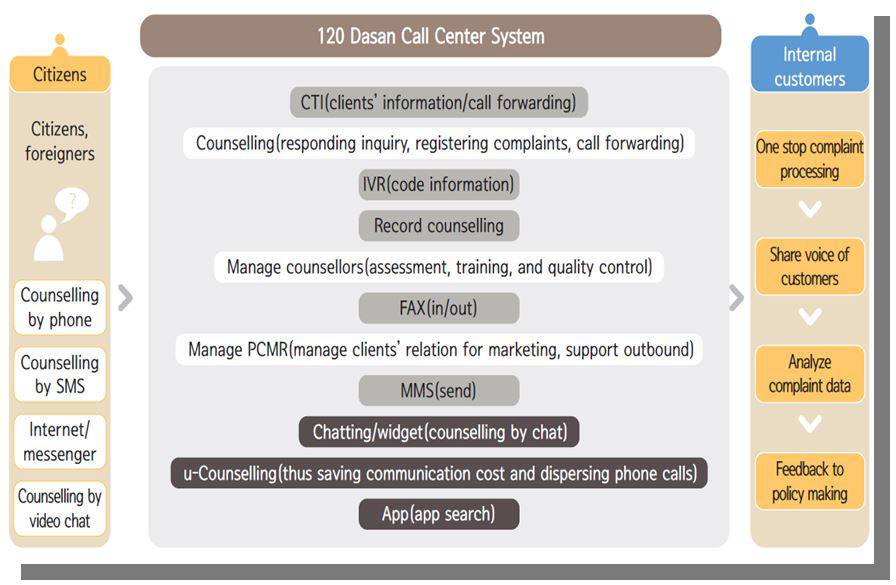
Who’s investing in the future of smart cities?
As illustrated in the examples above, cities around the globe are already implementing smart technologies to improve many aspects of urban living. Yet, these technologies are still new to the world and widespread adoption will take time.
Plenty of the world’s leading corporates and governments have invested in smart city technology to help further realize this goal. It’s clear that the smart city revolution is in full swing as governments, cities, and companies around the globe continue to make investments into developing and implementing smart technology that will transform life in urban areas as we know it.
Corporates
According to a 2017 report by Navigant Research, the top smart city suppliers include:
- Cisco
- Siemens
- Microsoft
- IBM
- Hitachi
- Huawei
- SAP
- Panasonic
- Ericsson
- GE
In 2017, Cisco dedicated $1B to building smart cities around the globe through the use of its Kinetic IoT platform, which has applications across smart city lighting, parking, safety, transportation, urban mobility, and more.
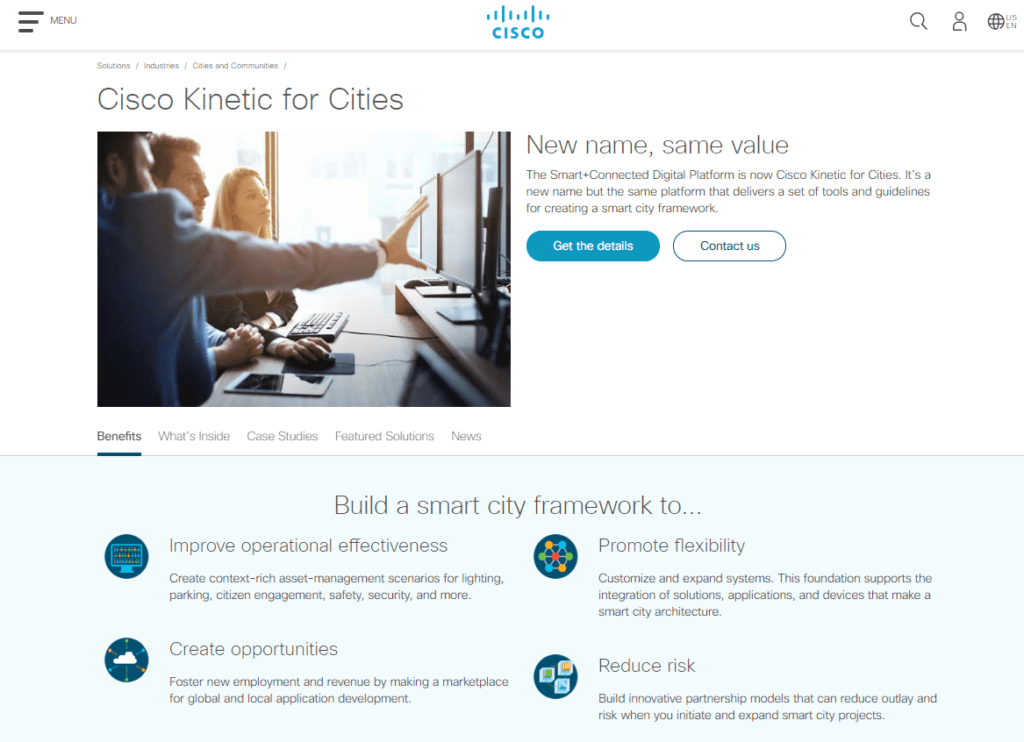
Further, its City Infrastructure Financing Acceleration Program has the goal of making it easier and more affordable for existing cities to become smart cities, by helping them deploy their technology with minimal initial investment. This assistance is crucial for cities that may struggle to find the funding to implement new smart technology.
In January 2020, Cisco launched a Cyber Vision product that focuses on security for industrial IoT systems.
Microsoft has also announced that it is investing $5B in IoT technology from 2018 to 2022, with the goal of improving the technologies required for smart cities to function. The company had already spent $1.5B on IoT initiatives prior to 2018.
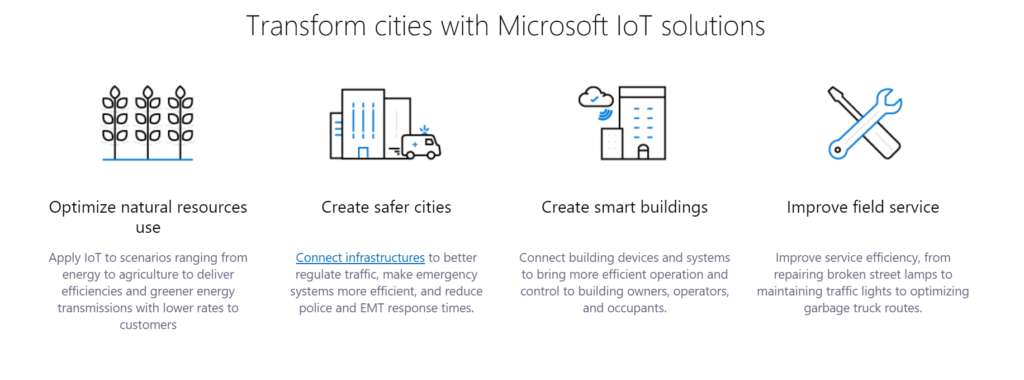
Companies including Walmart, Kohler, Chevron, and Johnson Controls all use Microsoft’s cloud platform, Azure, for a wide range of technologies. For example, Johnson Controls has created a smart thermostat for homes and buildings that optimize temperatures automatically. Walmart is leveraging IoT sensors on HVAC sensors and refrigeration systems to save energy.
In 2017, Bill Gates’ investment firm Cascade Investment bought a stake in 24,800 acres outside of Phoenix, Arizona, which will become a new smart city. The firm invested $80M into designing and creating features such as high-speed digital networks, data centers, infrastructure for autonomous vehicles, automated logistics hubs, and more. The firm has since invested in another patch of land in the city of Buckeye, though little has been revealed since its announcement.
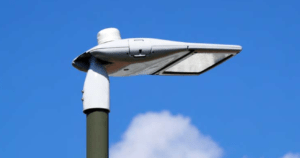
Another company, Telensa, has globally deployed more than 2M smart street lights across 400 cities that have saved cities up to 30% in energy costs.
Big tech
In addition to its Azure platform, Microsoft’s work on smart city tech extends to the CityNext initiative, which aggregates solutions across 5 categories: digitization, education, health, safety, and sustainability. The initiative is working on solutions for everything from parking management to traffic optimization to digital patrol, and more.
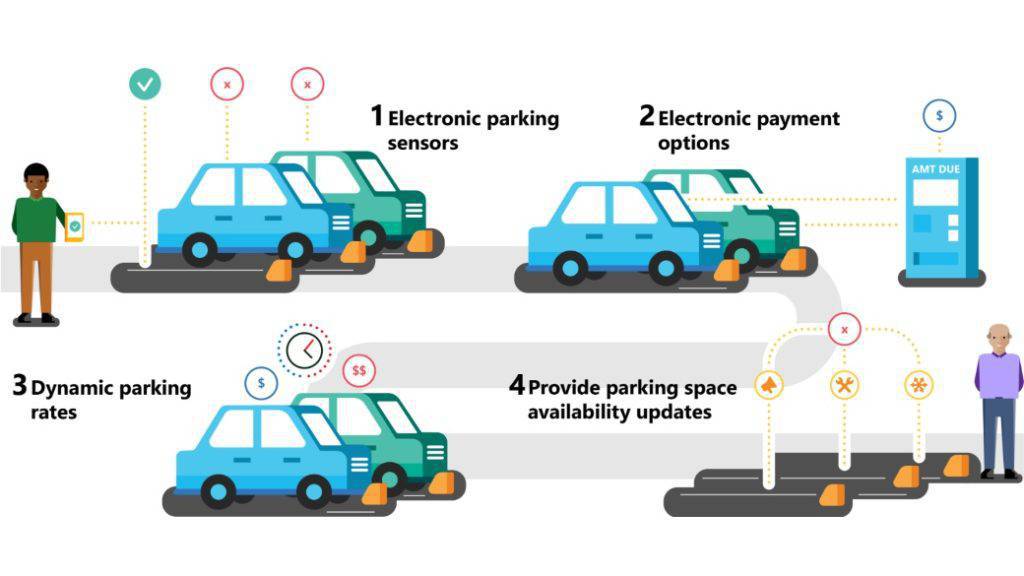
Snapshot of Microsoft’s Parking Management solution.
Sidewalk Labs — the urban innovation subsidiary of Alphabet, Google’s parent company — made a splash in 2017 when it announced that it was working on turning 800 acres of Toronto’s waterfront into an advanced smart city. Dubbed Quayside, this city-within-a-city would have had features such as dedicated self-driving car lanes, smart street lights, public Wi-Fi hubs, real-time transportation & parking information for the public, adaptable buildings, and other cutting-edge innovations designed to improve quality of life and increase sustainability. However, the project was shuttered in May 2020 in the wake of Covid-19 and regulatory uncertainty.
Amazon Web Services (AWS), a subsidiary of Amazon, offers a broad set of cloud-based products for smart cities, including IoT sensors and devices, management tools, storage, databases, analytics, and more. These technologies are used for a wide range of applications, including water quality monitoring, remote patient monitoring for healthcare providers, flood detection, snow level monitoring, smart analytics for transportation, public transportation applications, and more.
For instance, AWS has a software platform called PARK SMART that uses video sensors to provide real-time parking information via a mobile app.
Government initiatives
The United Nations Economic Commission for Europe (UNECE) has established a global initiative called United Smart Cities (USC), which is now integrated into the United for Smart Sustainable Cities Implementation Program. USC provides cities with support to develop smarter and more sustainable urban solutions by collaborating with international organizations, companies, governments, and high-level decision makers. It currently has the support of 17 UN agencies.
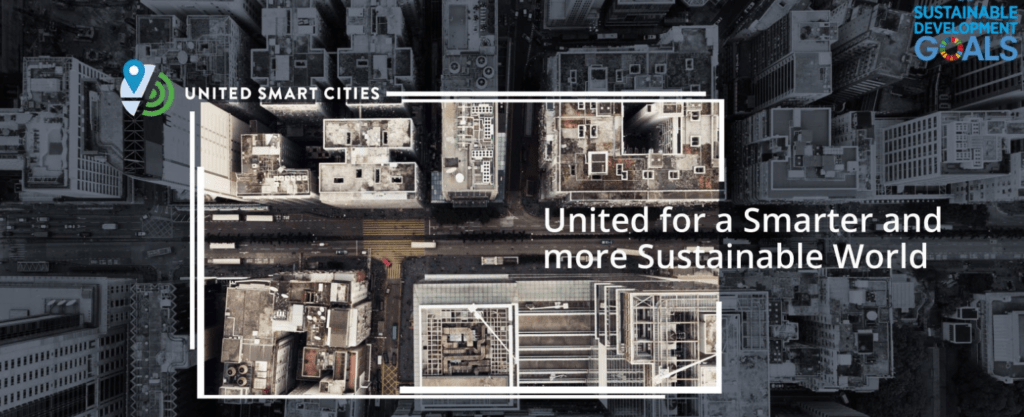
The USC platform is helping cities all over the world in the transition to become smart cities, from Barcelona all the way to districts in East Java, Indonesia.
It does this by first evaluating a city to determine its performance in sustainability. It provides advisory services to help a city decide which areas to focus on and assists in creating a tailor-made action plan for each city. USC then gives funding support while also assisting in partnerships between the public and private sectors to help cities develop and attain their goals.
Seoul, one of the pioneers in this space, remains one of the top smart cities in the world. One of the major problems that it’s addressed is what to do with waste.
Landfills were the predominant means of managing waste until the 1990s, when Seoul introduced resource recovery facilities. These transform waste into energy by incinerating solid urban waste at up to 950°C, allowing them to harness the heat from the process to use as an another source of energy.
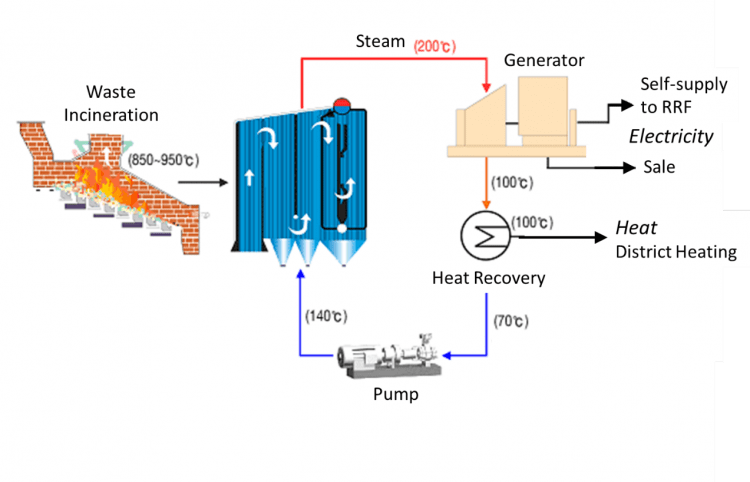
Source: Gangnam Resource Recovery Facility via World Bank
The Indian government launched the Smart Cities Mission, which aims to develop 100 smart cities across the country. The government will grant selected smart cities funding to implement smart city tech between 2018 and 2022.
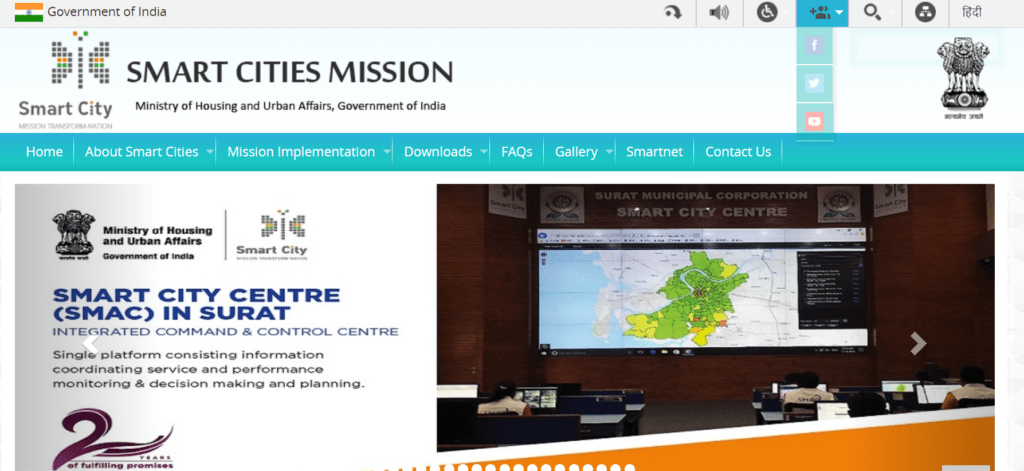
Selected cities plan to show results from 2022 onwards.
In the city of Jaipur, for example, the Indian government is assisting with the deployment of air quality monitoring technology to create “mega data” that will be accessible by citizens through a mobile app. Smart parking management technology was implemented across Madhya Pradesh, where sensors and cameras will collect data on parking lot capacity, though the program has recently run into cash flow issues.
In 2018, the mayor of London, Sadiq Khan, launched a roadmap to make London the “smartest city in the world,” called Smarter London Together.
This city-wide initiative intends to harness London’s tech talent in collaboration with the capital’s boroughs and public service sectors to improve sustainability and quality of life within London. These projects range from increasing public Wi-Fi availability to deploying “smart parks” that gather data on microclimates and air quality. The city has put together a report card that anyone can access via Trello.
London’s efforts are paying off: It was rated the number one smart city government in the world in a joint report by Eden Strategy Institute and OXD in 2018.
In November 2020, the first Southeast Asia-based smart cities development lab opened in Singapore, bringing together a variety of smart city solutions providers. The Smart Urban Co-Innovation Lab has already struck partnerships with companies like AWS, Cisco, and Johnson Controls, and is looking to partner with 200 local companies over the next 3 years.
Challenges and criticisms
The smart technology that gets implemented in cities has the potential to provide tremendous cost savings — in fact, an estimated $5T per year could be saved by governments, enterprises, and citizens throughout an aggregated 75 smart cities by 2022, according to a study by ABI Research.
However, cities need to first invest large amounts of money into these projects before they start paying off. Lack of proper funding is a large barrier that is keeping many cities from moving toward implementing smart technology.
Moreover, building the new infrastructure for smart cities is a complex process that takes years to complete. Thorough research is required before making such large and costly decisions, especially because each city must develop its own unique plan of action. The right smart solutions for a city in Nigeria, for example, would look very different from a city in Japan.
Some criticisms have also been made about potential downsides a smart city could pose.
Since smart cities rely on acquiring, recording, and analyzing data, there are concerns surrounding the privacy of citizens. The governmental bodies that aggregate all this information must use transparent practices to help assure the public that their data is not being misused. Should a corrupt government misuse the data it has on its citizens (like selling it to third parties), this would be a huge invasion of privacy. Therefore, city governments must have rigorous privacy protections in place that are known to the public.
There is also potential for public data to get stolen by hackers, which could be a large threat to the safety and security of individuals, governing bodies, and even the city itself. If smart technology is not securely encrypted or is without strong security protections, a hacker could manipulate devices around the city.
For example, someone could hack into smart traffic lights, take control, and turn them all red. This would wreak havoc on a city, as cars would inevitably begin running the red lights, resulting in accidents, while emergency vehicles such as police and ambulances would be prevented from getting to their destinations. A security researcher actually proved this was possible in Washington DC when he successfully hacked the system himself.
Putting high priority on strong security systems will be essential for smart cities, or else such vulnerabilities may leave them exposed to all manner of potentially catastrophic and costly events.
Conclusion
The development and implementation of smart technology systems throughout cities around the world is an inevitable trend to help cities become more efficient and sustainable.
There remains a long road ahead, as new infrastructure must be built and technological innovations must be perfected before they can go live. Yet, there are already aspects of smart technology systems in place and working successfully in many cities around the world, as witnessed in several countries’ responses to Covid-19.